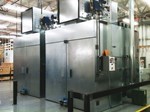Choosing The Right Powder Coating System
Tips on how to choose the system that best suites your coating needs.
#curing #masking
One of the most common questions asked of those in the powder coating industry is whether to use a manual batch-type system or an automated line.
The answer isn’t always easy: Batch systems and automated lines use different approaches to powder coating, each with their own advantages.
Featured Content

An automated system moves parts automatically through the various steps of the powder coating process.
For those unfamiliar with the terms, an automated system (or automated line) is a powder coating system that moves parts automatically through the various steps of the powder coating process. These steps usually include using a chemical wash to prepare the surface of the parts, drying the parts, applying the powder coating media, curing the powder coated finish onto the parts, then allowing them to cool.
The parts typically move in one direction from device to device, and all tasks are done to different parts simultaneously. A batch system, on the other hand, allows the operator to manually prepare and accumulate parts, then coat and cure the parts in batches. The parts are typically moved from one device to another by hand using carts.

A batch system allows the operator to manually prepare and accumulate parts, then coat and cure the parts in batches.
Here are some of the most useful tips for deciding whether a batch or automated system best suits a coater’s needs.
Consider the Volume of Work and the Nature of the Parts
If you’re dealing with thousands of similarly sized parts per shift, an automated system is probably your best bet. The more varied the shape and size of the parts, the less advantage an automated system typically offers. A batch system provides significant benefits in terms of powder coating equipment cost and workflow versatility, but relies on workers to move parts, prep parts and apply powder coating media. So, if the volume of parts is quite large, the advantages of a batch system are lost.
Determine How Quickly You’ll Need Parts to be Coated
If the coating process outpaces the manufacturing process, a batch system is ideal. If the powder coating process delays output, an automated system may help. You can coat large quantities of similar items quickly, since parts don’t have to be handled between stages. If the automated line is designed for rapid throughput, a constant flow of parts can be coated at a rate that usually can’t be matched by manual techniques.
Evaluate Floor Space
Batch systems generally take up less room, so they’re better for businesses that can’t spare extra space. Batch systems sometimes use one oven to do the work of both drying and curing parts, which further reduces cost and saves on floor space. By using ovens where the parts move back and forth multiple times inside relatively short but wide enclosures, some automated lines fit into surprisingly tight spaces. But most automated lines involve restricted access to at least some key components, especially in cramped spaces. This drives maintenance and repair costs up.
Consider Your Budget
Batch systems are significantly cheaper than comparable automated lines, usually costing less than half as much, so if your budget is tight it might be best to start with a batch system. Batch equipment requires more manpower, but also tends to have lower maintenance costs. Batch systems can also provide lower operating costs because you only use equipment as it is needed. With automated systems there is almost always a constant process of coating taking place, so relative operating costs can increase if the system is not being used to full capacity.
No matter what type of system is used, have a plan for growth and size your equipment accordingly.
For more information, please visit reliantfinishingsystems.com or whatispowdercoating.com.
RELATED CONTENT
-
8 Things You Need to Know About Paint Booth Lighting
Global Finishing Solutions has come up with some helpful insights on lighting for paints booths which plays a crucial role in achieving a quality paint job.
-
Corrosion Testing of Automotive Coatings
Exposure to road salts, UV radiation, heat, moisture and chipping from kicked-up road debris can quickly degrade an automotive coating system.
-
Plating Q&A: Can you color stainless steel?
Our expert, Art Kushner, says yes, you can color stainless steel, but it is not a process that is typically performed in a plating shop. Read more about his answer.


















